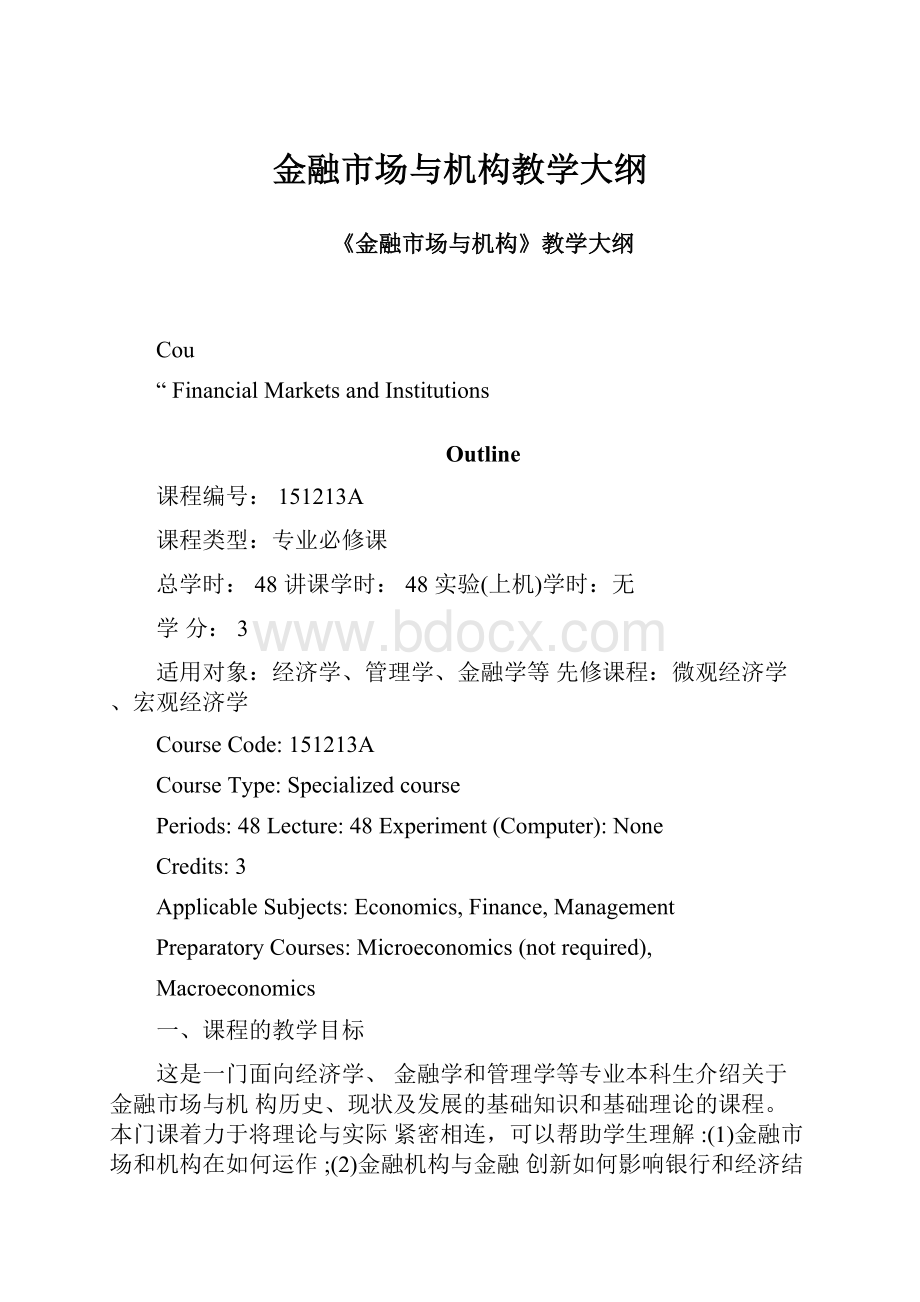金融市场与机构教学大纲.docx
《金融市场与机构教学大纲.docx》由会员分享,可在线阅读,更多相关《金融市场与机构教学大纲.docx(15页珍藏版)》请在冰豆网上搜索。

金融市场与机构教学大纲
《金融市场与机构》教学大纲
Cou
“FinancialMarketsandInstitutions
Outline
课程编号:
151213A
课程类型:
专业必修课
总学时:
48讲课学时:
48实验(上机)学时:
无
学分:
3
适用对象:
经济学、管理学、金融学等先修课程:
微观经济学、宏观经济学
CourseCode:
151213A
CourseType:
Specializedcourse
Periods:
48Lecture:
48Experiment(Computer):
None
Credits:
3
ApplicableSubjects:
Economics,Finance,Management
PreparatoryCourses:
Microeconomics(notrequired),
Macroeconomics
一、课程的教学目标
这是一门面向经济学、金融学和管理学等专业本科生介绍关于金融市场与机构历史、现状及发展的基础知识和基础理论的课程。
本门课着力于将理论与实际紧密相连,可以帮助学生理解:
(1)金融市场和机构在如何运作;
(2)金融机构与金融创新如何影响银行和经济结构;(3)货币政策,经济周期与其它经济变量间的联系。
学完本门课程,学生应对经济活动中金融市场和机构所扮演的角色有系统的理解和认识,并具备分析宏观经济变动对各金融市场各组成影响的能力。
Thisisaspecializedcourseinthebasicknowledgeandtheoryaboutthehistory,currentandfutureoutlookoffinancialmarketsandfinancialinstitutionsforstudentsmajoringinEconomics,FinanceandManagement.Thiscoursecloselycombinestheoryandpractice.Thiscoursehelpsthestudentinunderstanding:
(1)howfinancialmarketsandinstitutionsworkintheeconomy;
(2)howfinancialintermediationandfinancialinnovationaffectbankingandtheeconomy;(3)thebasiclinksamongmonetarypolicy,thebusinesscycle,andeconomicvariablesAfterlearningthiscourse,thestudentshouldbeabletoidentifyandexplainthefunctionsoffinancialmarketsandfinancialinstitutionsintherealeconomy.Furthermore,theyshouldalsobeabletoanalyzehowmacroeconomicshocksaffectthefinancialsystem.
二、教学基本要求(黑体,小四号字)
本课程主要是从经济学的角度来学习金融系统。
全课程的核心包括两个层次
的难点1股市,债市,和货币市场组成元素、运行规则以及市场价格形成机制。
2,运用经济学理论来分析宏观变量对于各个市场以及产品价格的影响。
为了达到这个目标,需要紧密联系现实情况,通过分析热点问题培养学生学兴趣,同时
揭示信息不对称以及机制设计等学习难点,让学生更快且更深入的理解整个金融市场的运作。
对于学生不仅需要他们了解书本上的知识,更需要紧密地追踪市场
新闻,并且不断地利用所学的知识来进行分析,并根据市场走势来验证自己的判
断。
本课程预计将设计8次作业并采用两次期中一次期末的闭卷考试方式进行考核。
本课最终的成绩将取决于出勤,作业以及考试的加总。
分数加总的方式如下
总分数(100%)
项目
出勤
作业
期中1
期中2
期末
分项权重
5%
15%
15%
20%
45%
Thiscoursestudiesthefinancialsystemfromaneconomicperspective.Students
willexaminemajorfinancialassetsandmarkets,financialintermediation,centralbankingandmonetarypolicy.Tohelpstudentsconstructtheunderstandingoffinancialmarketsquickly,thiscoursedividesfinancialmarketsandinstitutionsintotwolevels.Thefirstlevelisbasedonthediscussionofthecomponentsoffinancialmarketswhichincludetheoperationsoffinancialmarketsandthepricesettingmechanism.Thesecondlevelisbasedonanalyzinghoweconomicconditionsaffectthecomponentsoffinancialmarketsandinstitutions.Beforeembarkingonthestudyofthiscourse,thestudentmustbeconvincedthatfinancialmarketandinstitutionsisanexcitingfieldbecauseitfocusesoneconomicphenomenathataffecteverydaylife.Talkingaboutthedataandnewsfromrealmarketshelpsthestudentstogetfamiliarwiththerealworldandstrengthentheirabilitiestoapplythetheoriesfromthiscoursetoanalyzingtherealmarkets.Thereshouldbearound8problemsets,twomidtermexams,andonefinalexamforthiscourse.Thecoursegradeisbasedonlectureattendance,assignments,andexams.Theywillcounttowardthetotalnumericalgradeasfollows:
TotalNumericalGrade(100%)
Item
Attendance
Assignment
MidtermI
MidtermII
Final
Percent
5%
15%
15%
20%
45%
三、各教学环节学时分配
教学课时分配
序号
早节内谷
讲课
实验
其他
合计
1
绪论
2
2
2
金融市场
10
10
3
金融机构
13
13
4
央行和货币政策
13
13
5
货币理论
10
10
合计
48
48
TimeDistribution
No.
Content
Hours
Lab
Others
Total
1
Introduction
2
2
2
FinancialMarkets
10
10
3
FinancialInstitutions
13
13
4
CentralBankingandtheConductofMonetaryPolicy
13
13
5
MonetaryTheory
10
10
Total
48
48
四、教学内容
第1章绪论
第一节为什么学习金融市场与金融机构
1.为什么学习金融市场?
2.为什么学习金融机构?
3.为什么学习货币和货币政策?
第二节金融系统总览
1.金融市场功能
2.金融市场结构
3.金融市场工具
第二节什么是货币
1.货币的定义和功能
2.支付系统的演变
教学重点、难点:
了解金融市场与金融中介对资本的分配意义,货币的经济
学意义
课程的考核要求:
熟练掌握金融市场的基本组成,掌握货币经济学意义
Chapter1Introduction
Section1WhyStudyMoney.Banking,andFinancialMarkets?
1.WhyStudyFinancialMarkets?
2.WhyStudyFinancialInstitutionsandBanking?
3.WhyStudyMoneyandMonetaryPolicy?
Section2AnOverviewoftheFinancialSystem
1.FunctionofFinancialMarkets
2.StructureofFinancialMarkets
Section3WhatisMoney
1.MeaningandFunctionsofMoney
2.EvolutionofthePaymentsSystem
KeyandDifficultPoints:
thefunctionsoffinancialmarketsandfinancialintermediatesindistributingthecapital,understandmoneyfromaneconomicpespective
EvaluationRequirements:
beproficientinunderstandingtheconstructionoffinancialmarkets,masterthemeaningofmonetaryeconomics
第2章金融市场第一节利率的定义
1.测量利率
2.利率与收益的区别
3.实际与名义利率第二节利率的行为
1.资产需求决定要素
2.债券市场的供给与需求
3.均衡利率的变动第三节利率的风险与期限结构
1.利率的风险结构
2.利率的期限结构第四节股票市场,理性预期,和有效市场假说
1.计算普通股票价格
2.市场如何决定股票价格
3.理性预期假说
4.市场有效性假说教学重点、难点:
利率与收益的区别,有效市场假说,债券市场利率决定课程的考核要求:
熟练掌握利率的决定因素,熟练掌握债券市场对利率的影响,理解理性预期理论以及有效市场假说
Chapter2FinancialMarkets
Section1TheMeaningofInterestRates
1.MeasuringInterestRates
2.TheDistinctionBetweenInterestRatesandReturns
3.TheDistinctionBetweenRealandNominalInterestRates
Section2TheBehaviorofInterestRates
1.DeterminantsofAssetDemand
2.SupplyandDemandintheBondMarket
3.ChangesinEquilibriumInterestRates
Section3TheRiskandTermStructureofInterestRates
1.RiskStructureofInterestRate
2.TermStructureofInterestRates
Section4TheStockMarket,theTheoryofRationalExpectations,andtheEfficient
1.ComputingthePriceofCommonStock
2.HowtheMarketSetsStockPrices
3.TheTheoryofRationalExpectations
4.TheEfficientMarketHypothesis:
RationalExpectationsinFinancialMarkets
KeyandDifficultPoints:
Distinguishthedifferencebetweeninterestrateandreturn,EfficientMarketHypothesis,Howthemarketsetsinterestrate
EvaluationRequirements:
beproficientinexplainingthedeterminantsforinterestrates,beproficientinexplainingtheperformanceofbondratesinbond
markets,andunderstandrationalexpectationsandefficientmarkethypothesis第3章金融机构
第一节金融结构的经济学分析
1.世界金融结构的基本特点
2.交易成本
3.不对称信息
4.逆向选择对金融结构的影响
5.道德风险对股票与债券市场影响第二节银行系统与金融机构管理
1.银行资产负债表
2.银行基本知识
3.银行管理概要
4.信贷风险管理
5.利率风险管理
6.表外业务第三节金融监管的经济学分析
1.不对称信息
2.金融监管种类第四节银行产业:
结构与竞争
1.银行系统的历史发展
2.金融创新与影子银行
3.商业银行结构
4.全球银行结构比较
5.分业与混业经营
第五节金融危机
1.什么是金融危机
2.金融危机的动态发展
3.2007-2009年金融危机
4.金融监管的反应第六节非银行金融
1.保险业
2.年金
3.金融公司
4.债券公司
5.共同基金
6.对冲基金
7.私募及风险投资
第七节金融产业的利益冲突
1.什么是利益冲突
2.利益冲突种类
3.市场是否会消灭利益冲突
教学重点、难点:
不对称信息,金融危机成因,银行资产负债表管理,利益冲突原理
课程的考核要求:
熟练掌握不对称信息在金融市场中的表现,理解利率的决定因素,理解金融危机的成因和表现,熟练掌握非银行金融部门种类和职能
Chapter3FinancialInstitutions
Section1AnEconomicAnalysisofFinancialStructure
1.BasicFactsAboutFinancialStructureThroughouttheWorld
2.TransactionCosts
3.AsymmetricInformation:
AdverseSelectionandMoralHazard
4.TheLemonsProblem:
HowAdverseSelectionInfluencesFinancial
Structure
5.HowMoralHazardAffectstheChoiceBetweenDebtandEquityContracts
Section2BankingandtheManagementofFinancialInstitutions
1.TheBankBalanceSheet
2.BasicBanking
3.GeneralPrinciplesofBankManagement
4.ManagingCreditRisk
5.ManagingInterest-RateRisk
6.Off-Balance-SheetActivitiesSection3EconomicAnalysisofFinancialRegulation
1.AsymmetricInformationasaRationaleforFinancialRegulation
2.TypesofFinancialRegulation
Section4BankingIndustry:
StructureandCompetition
1.HistoricalDevelopmentoftheBankingSystem
2.FinancialInnovationandtheGrowthofthe“ShadowBankingSystem”
3.StructureoftheU.S.CommercialBankingIndustry
4.SeparationofBankingandOtherFinancialServiceIndustriesSection5FinancialCrisis
1.WhatIsaFinancialCrisis?
2.DynamicsofFinancialCrises
3.TheGlobalFinancialCrisisof2007-2009
4.ResponseofFinancialRegulationSection6NonbankFinance
1.Insurance
2.PensionFunds
3.FinanceCompanies
4.SecuritiesMarketOperations
5.MutualFunds
6.HedgeFunds
7.PrivateEquityandVentureCapitalFunds
Section7ConflictsofInterestintheFinancialIndustry
1.WhatAreConflictsofInterest,andWhyAreTheyImportant?
2.EthicsandConflictsofInterest
3.CantheMarketLimitExploitationsofConflictsofInterest?
KeyandDifficultPoints:
Asymmetricinformation,CausesofFinancialCrisis,managementofBankBalanceShee,tthetheoriesofconflictsofInterest
EvaluationRequirements:
beProficientinExplainingthePhenomenoncausedbyAsymmetricInformation,MastertheCausesandResultsofFinancialCrises,beProficientinunderstandingtheFunctionsandComponentsofNonbankFinance
第4章中央银行与货币政策第一节中央银行与美联储
1.美联储的起源
2.美联储的架构
3.美联储的独立性
4.其他国家央行的独立性
第二节货币供给
1.货币供给的三个决定者
2.美联储的资产负债表
3.控制基础货币
4.储蓄创造:
一个简单模型
5.货币供给的决定因素
6.货币供给总览
7.货币乘数第三节货币政策工具
1.储备金和联邦基金
2.传统储备金利率
3.非传统货币工具和量化宽松第四节施行货币政策:
目标,策略,和战术
1.价格稳定目标和名义锚定
2.其他货币政策目标
3.价格稳定应该成为货币政策主要目标吗?
4.盯住通胀
5.美联储的货币政策策略演变
6.全球金融危机的教训
7.央行是否应该阻止信贷泡沫
8.战术:
泰勒规则教学重点、难点:
美联储架构,货币供给决定因素,传统货币工具与非传统货币工具的优缺点,货币政策目标的原因及可行性
课程的考核要求:
了解美联储架构,熟悉掌握货币供给原理,熟练掌握传统与非传统货币政策意义
Chapter4CentralBankingandTheConductofMonetaryPolicySection1CentralBanksandtheFederalReserveSystem
1.OriginsoftheFederalReserveSystem
2.StructureoftheFederalReserveSystem
3.HowIndependentIstheFed?
4.StructureandIndependenceofOtherCentralBanks
Section2TheMoneySupplyProcess
1.ThreePlayersintheMoneySupplyProcess
2.TheFed'sBalanceSheet
3.ControloftheMonetaryBase
4.MultipleDepositCreation:
ASimpleModel
5.FactorsthatDeterminetheMoneySupply
6.OverviewoftheMoneySupplyProcess
7.TheMoneyMultiplier
Section3ToolsofMonetaryPolicy
1.TheMarketforReservesandtheFederalFundsRate
2.ConventionalMonetaryInterestonReserves
3.Non